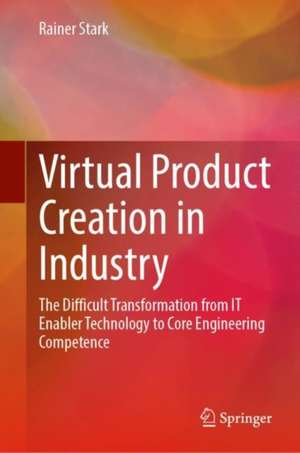Virtual Product Creation in Industry: The Difficult Transformation from IT Enabler Technology to Core Engineering Competence
Autor Rainer Starken Limba Engleză Hardback – 25 dec 2021
The book concentrates on explaining the critical basics of the individual technologies, before going into deeper analysis of the virtual solution interdependencies and guidelines on how to best align them for productive deployment in industrial and collaborative networks. Moreover, it addresses the changes needed in both, technical and management skills, in order to avoid fundamental breakdowns in running information technologies for virtual product creation in the future.
Preț: 1024.08 lei
Preț vechi: 1248.87 lei
-18% Nou
Puncte Express: 1536
Preț estimativ în valută:
196.02€ • 212.99$ • 164.76£
196.02€ • 212.99$ • 164.76£
Carte tipărită la comandă
Livrare economică 21 aprilie-05 mai
Preluare comenzi: 021 569.72.76
Specificații
ISBN-13: 9783662642993
ISBN-10: 3662642999
Pagini: 656
Ilustrații: XXXIII, 656 p. 325 illus., 312 illus. in color.
Dimensiuni: 155 x 235 mm
Greutate: 1.14 kg
Ediția:1st ed. 2022
Editura: Springer Berlin, Heidelberg
Colecția Springer
Locul publicării:Berlin, Heidelberg, Germany
ISBN-10: 3662642999
Pagini: 656
Ilustrații: XXXIII, 656 p. 325 illus., 312 illus. in color.
Dimensiuni: 155 x 235 mm
Greutate: 1.14 kg
Ediția:1st ed. 2022
Editura: Springer Berlin, Heidelberg
Colecția Springer
Locul publicării:Berlin, Heidelberg, Germany
Cuprins
Motivation and approach.- The big picture - Information technology in enterprises.- Virtual Product Creation (VPC)- what is it?- The technology history of Virtual Product Creation.- The role of Virtual Product Creation for Engineering and PLM- evolving from IT.- The traditional approach of Virtual Product Creation in industry and its flaws.- The major technologies of Virtual Product Creation (CAID, CAD, CAM, CAE, PDM/BOM, DMU, VR, AR, Digital Factory).- The hidden demands of the engineering community.- Best practices of integrating Virtual Product Creation into mainstream engineering.- The challenge of modifying Management Leadership behavior towards Virtual Product Creation in enterprises.- The role and future of IT/PLM vendors.- Outlook to future Virtual Product Creation solutions.
Notă biografică
Prof. Dr.-Ing. Rainer Stark is University Professor and Director of the Chair of Industrial Information Technology at the TU Berlin (Faculty of Mechanical Engineering and Transport Systems, Department of Machine Tools and Factory Management) since 2008. Besides his additional leadership responsibility as Director of the division "Virtual Product Creation" at the Fraunhofer Institute for Production Systems and Design Technology until 2021 he serves as active member in the acatech research council Industrie 4.0, as board member of the prostep ivip association and as member in national and international academic societies (WiGeP, CIRP, Design Society).
He previously worked in the automotive industry for nearly 14 years: first as a system engineer in the area of car body development for roughly four years, and then as Technical Leader / Manager of C3P (CAD, CAM, CAE, Product Information Management) and Digital Engineering in various national and international positions(including responsibility for digital methods for Ford, Jaguar/Land Rover, Volvo and Mazda).
He previously worked in the automotive industry for nearly 14 years: first as a system engineer in the area of car body development for roughly four years, and then as Technical Leader / Manager of C3P (CAD, CAM, CAE, Product Information Management) and Digital Engineering in various national and international positions(including responsibility for digital methods for Ford, Jaguar/Land Rover, Volvo and Mazda).
Textul de pe ultima copertă
Today, digital technologies represent an absolute must when it comes to creating new products and factories. However, day-to-day product development and manufacturing engineering operations have still only unlocked roughly fifty percent of the "digital potential". The question is why? This book provides compelling answers and remedies to that question. Its goal is to identify the main strengths and weaknesses of today’s set-up for digital engineering working solutions, and to outline important trends and developments for the future.
The book concentrates on explaining the critical basics of the individual technologies, before going into deeper analysis of the virtual solution interdependencies and guidelines on how to best align them for productive deployment in industrial and collaborative networks. Moreover, it addresses the changes needed in both, technical and management skills, in order to avoid fundamental breakdowns in running information technologies for virtual product creation in the future.
The book concentrates on explaining the critical basics of the individual technologies, before going into deeper analysis of the virtual solution interdependencies and guidelines on how to best align them for productive deployment in industrial and collaborative networks. Moreover, it addresses the changes needed in both, technical and management skills, in order to avoid fundamental breakdowns in running information technologies for virtual product creation in the future.
Caracteristici
Presents technical publication with a unique combination of scientific/technological information Offers an understanding of, and outlook on, how PLM and virtual product creation technology can be used Addresses the changes needed in order to avoid fundamental breakdowns in running information technologies
